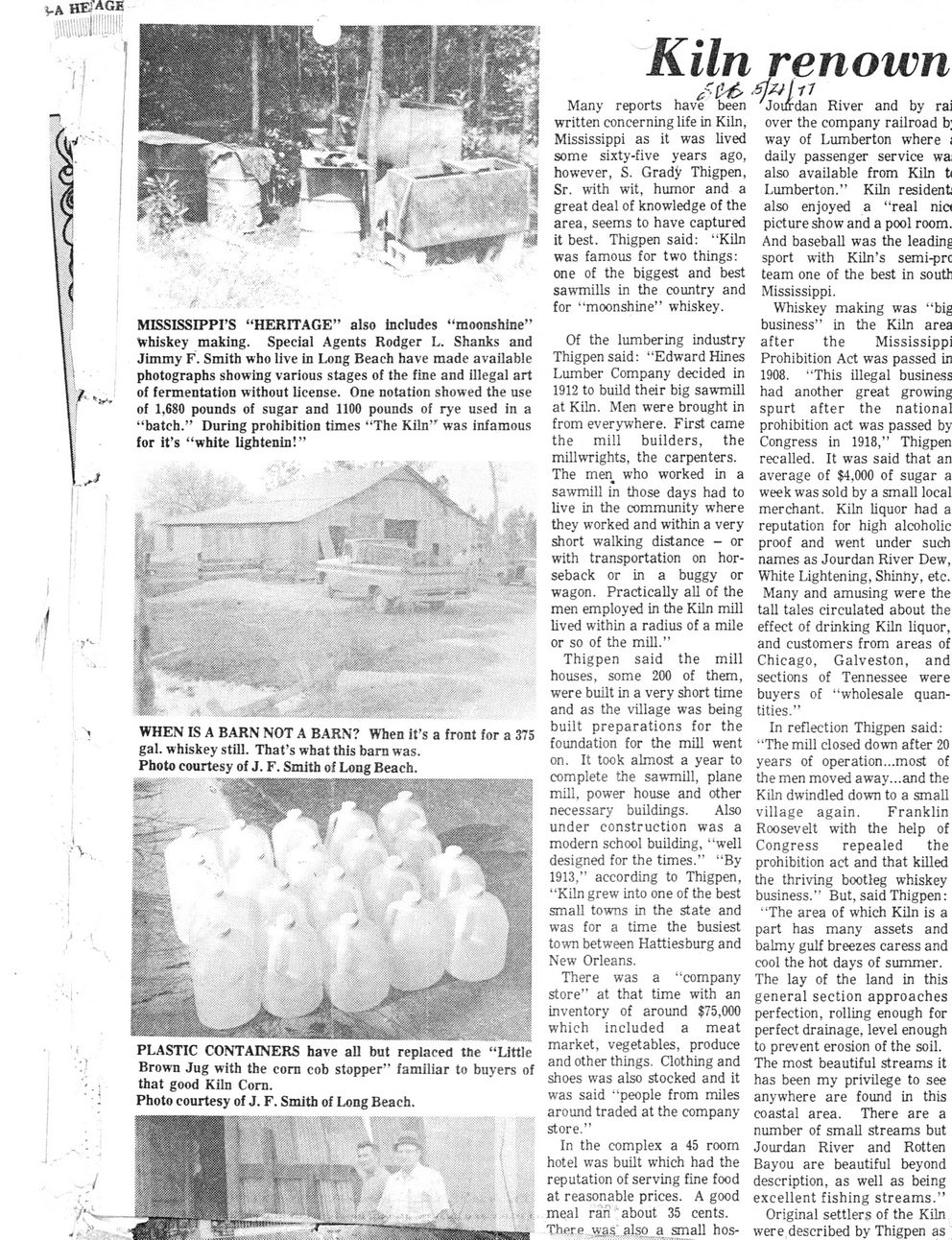This text was obtained via automated optical character recognition.
It has not been edited and may therefore contain several errors.
Kiln $-0*0 * MISSISSIPPI’S “HERITAGE” also includes “moonshine” whiskey making. Special Agents Rodger L. Shanks and Jimmy F. Smith who live in Long Beach have made available photographs showing various stages of the fine and illegal art of fermentation without license. One notation showed the use of 1,680 pounds of sugar and 1100 pounds of rye used in a “batch.” During prohibition times “The Kiln” was infamous for it’s “white lightenin!” WHEN IS A BARN NOT A BARN? When it’s a front for a 375 gal. whiskey still. That’s what this barn was. Photo courtesy of J. F. Smith of Long Beach. PLASTIC CONTAINERS have all but replaced the “Little Brown Jug with the corn cob stopper” familiar to buyers of that good Kiln Corn. Photo courtesy of J. F. Smith of Long Beach. % '/'S ’'fXKi ■f n - Many reports have been written concerning life in Kiln, Mississippi as it was lived some sixty-five years ago, however, S. Grady Thigpen, Sr. with wit, humor and a great deal of knowledge of the area, seems to have captured it best. Thigpen said: “Kiln was famous for two things: one of the biggest and best sawmills in the country and for “moonshine” whiskey. Of the lumbering industry Thigpen said: “Edward Hines Lumber Company decided in 1912 to build their big sawmill at Kiln. Men were brought in from everywhere. First came the mill builders, the millwrights, the carpenters. The men who worked in a sawmill in those days had to live in the community where they worked and within a very short walking distance - or with transportation on horseback or in a buggy or wagon. Practically all of the men employed in the Kiln mill lived within a radius of a mile or so of the mill.” Thigpen said the mill houses, some 200 of them, were built in a very short time and as the village was being built preparations for the foundation for the mill went on. It took almost a year to complete the sawmill, plane mill, power house and other necessary buildings. Also under construction was a modern school building, “well designed for the times.” “By 1913,” according to Thigpen, “Kiln grew into one of the best small towns in the state and was for a time the busiest town between Hattiesburg and New Orleans. There was a “company store” at that time with an inventory of around $75,000 which included a meat market, vegetables, produce and other things. Clothing and shoes was also stocked and it was said “people from miles around traded at the company store.” In the complex a 45 room hotel was built which had the reputation of serving fine food at reasonable prices. A good meal ran about 35 cents. There v£a§ also a small hos- renown fah! Joiffdan River and by rai over the company railroad b; way of Lumberton where j daily passenger service wa also available from Kiln t< Lumberton.” Kiln resident also enjoyed a “real nic« picture show and a pool room. And baseball was the leading sport with Kiln’s semi-prc team one of the best in south Mississippi. Whiskey making was “big business” in the Kiln area after the Mississippi Prohibition Act was passed in 1908. “This illegal business had another great growing spurt after the national prohibition act was passed by Congress in 1918,” Thigpen recalled. It was said that an average of $4,000 of sugar a week was sold by a small local merchant. Kiln liquor had a reputation for high alcoholic proof and went under such names as Jourdan River Dew, White Lightening, Shinny, etc. Many and amusing were the tall tales circulated about the effect of drinking Kiln liquor, and customers from areas of Chicago, Galveston, and sections of Tennessee were buyers of “wholesale quantities.” In reflection Thigpen said: "The mill closed down after 20 years of operation...most of the men moved away...and the Kiln dwindled down to a small village again. Franklin Roosevelt with the help of Congress repealed the prohibition act and that killed the thriving bootleg whiskey business.” But, said Thigpen: “The area of which Kiln is a part has many assets and balmy gulf breezes caress and cool the hot days of summer. The lay of the land in this general section approaches perfection, rolling enough for perfect drainage, level enough to prevent erosion of the soil. The most beautiful streams it has been my privilege to see anywhere are found in this coastal area. There are a number of small streams but Jourdan River and Rotten Bayou are beautiful beyond description, as well as being excellent fishing streams.” Original settlers of the Kiln were described by Thigpen as

Kiln Renowned Center for Sawmills and Whiskey (1)